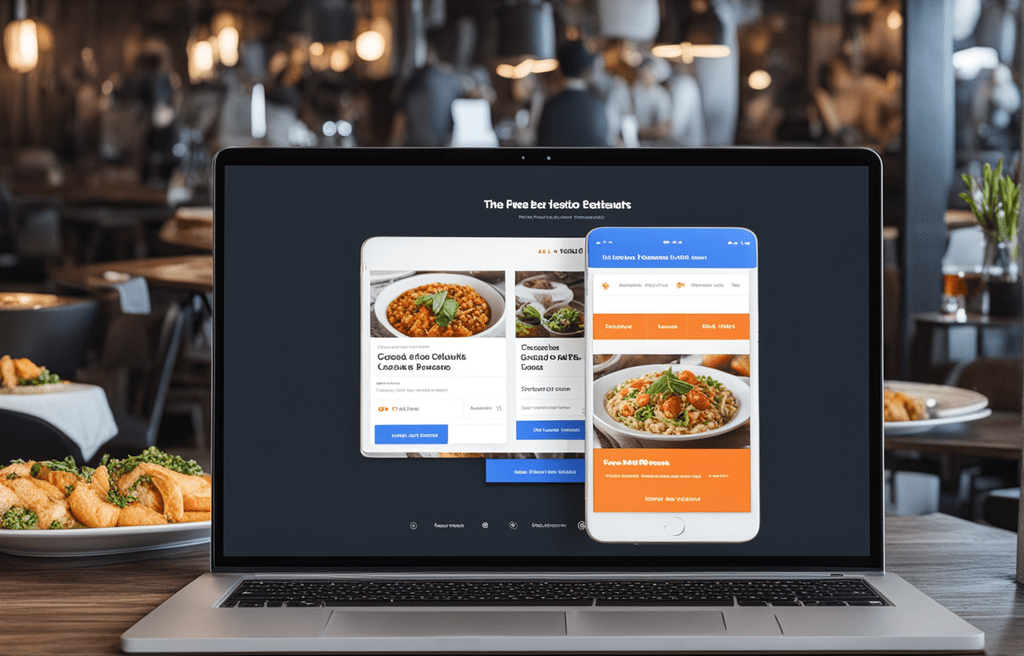
The best Local SEO for Restaurants Filling Tables with Online Presence 2023

Introduction
Local SEO is a powerful marketing strategy for restaurants to attract more diners, increase foot traffic, and fill tables with their online presence In the digital age, potential customers rely heavily on search engines to find nearby eateries By optimizing for local SEO, restaurants can improve their visibility in local search results and establish a strong online presence In this article, we will explore the significance of local SEO for restaurants and effective strategies to attract diners and fill tables
1 Claim and Optimize Google My Business (GMB) Listing
Start by claiming and optimizing your restaurant’s Google My Business (GMB) listing Provide accurate business information, including name, address, phone number, website URL, and operating hours Ensure your listing is complete and up-to-date
- Claim Your GMB Listing: The first step in harnessing the potential of GMB is to claim your listing. Many businesses overlook this fundamental step, which can result in inaccurate information being displayed or missed opportunities. Claiming your listing gives you control over the information presented, allowing you to provide accurate details about your business.
- Go to the Google My Business website or app.
- Search for your business to see if a listing already exists.
- If found, claim the listing by following the verification process.
- If not found, create a new listing with accurate information.
- Ensure Accuracy of Business Information: A well-optimized GMB listing starts with accurate and up-to-date information. Make sure your business name, address, phone number (NAP), website, and other essential details are correct. Consistent and accurate information not only improves user experience but also boosts your local SEO.
- Select Relevant Categories: Choose the most relevant categories for your business. Categories help Google understand the nature of your business and match it with user queries. Selecting accurate categories enhances the likelihood of your business appearing in relevant local searches.
- Craft an Engaging Business Description: Use the business description section to provide a concise yet compelling overview of your offerings. Highlight your unique selling points and convey the value your business brings to customers. Aim for clarity and conciseness while incorporating relevant keywords.
- Add High-Quality Photos: Visual content plays a crucial role in attracting potential customers. Upload high-quality photos that showcase your products, services, and the overall ambiance of your business. Include images of your storefront, interior, team members, and any other aspects that reflect the personality of your brand.
- Encourage and Respond to Reviews: Customer reviews significantly impact your business’s reputation and visibility. Encourage satisfied customers to leave positive reviews and promptly respond to any negative feedback. Engaging with reviews demonstrates your commitment to customer satisfaction and can improve your local search ranking.
- Utilize GMB Posts: Take advantage of the GMB Posts feature to share updates, promotions, and events directly on your listing. Regularly posting relevant content keeps your audience informed and engaged, potentially attracting more customers.https://csspmstimes.com
- Monitor Insights and Analytics: GMB provides valuable insights into how users interact with your listing. Monitor these analytics regularly to understand your audience, track performance, and identify areas for improvement. Use this data to refine your strategy and enhance your online presence.
2 Utilize Local Keywords Restaurants
Conduct local keyword research to identify relevant and location-specific keywords Use these keywords throughout your website content, meta tags, and GMB listing to improve local search visibility

3 Optimize Your Website for Local SEO
Optimize your restaurant’s website for local SEO by incorporating location-based keywords in page s, meta descriptions, and content Ensure that your website is mobile-friendly for a seamless user experience on all devices
- Keyword Research for Local Relevance: Start by identifying and incorporating location-specific keywords into your website content. Think about terms your local audience might use when searching for products or services. Include city names, neighborhoods, and other location-based phrases strategically in your website’s meta tags, headers, and content.
- Optimize On-Page Elements: Ensure that your website’s on-page elements are optimized for local search. This includes title tags, meta descriptions, and header tags. Craft compelling and concise meta descriptions that not only incorporate relevant keywords but also entice users to click through to your site.
- Create a Consistent NAP: Maintain a consistent Name, Address, and Phone Number (NAP) across your website, social media profiles, and any online directories. Consistency builds trust with search engines and ensures that your business information is accurate, contributing to improved local search rankings.
- Claim and Optimize Google My Business (GMB) Listing: As mentioned earlier, claiming and optimizing your GMB listing is crucial for local SEO. Ensure your business details, categories, description, and images are accurate and engaging. Regularly update your GMB listing with relevant posts and promotions to keep customers informed.
- Leverage Local Structured Data Markup: Implement local structured data markup on your website to provide search engines with additional information about your business, such as operating hours, pricing, and customer reviews. Structured data markup can enhance the visibility of rich snippets in search results, providing more information to potential customers.
- Mobile Optimization: With the increasing use of mobile devices, it’s imperative to have a mobile-friendly website. Google prioritizes mobile-responsive sites, and a positive mobile experience contributes to better local search rankings. Optimize your site for mobile users with responsive design, fast loading times, and easy navigation.
- Local Content Creation: Develop content that caters specifically to your local audience. This could include blog posts, articles, or landing pages that address local events, news, or community topics. Localized content not only improves your relevance to local searches but also demonstrates your commitment to the community.
- Earn Quality Local Backlinks: Building a network of quality local backlinks from reputable websites can significantly impact your local SEO. Reach out to local businesses, chambers of commerce, and community organizations for potential link-building opportunities. Genuine, relevant backlinks contribute to your site’s authority.
- Encourage Online Reviews: Positive online reviews not only boost your reputation but also influence local search rankings. Encourage satisfied customers to leave reviews on platforms like Google, Yelp, and other relevant review sites. Respond to reviews promptly, addressing both positive and negative feedback.
- Monitor and Adjust Strategy: Regularly monitor your website’s performance using analytics tools. Track local keyword rankings, user behavior, and conversion metrics. Use the insights gained to refine your local SEO strategy, making adjustments as needed to stay competitive in the local market.
4 Showcase Your Menu and Specials
Create an enticing and easy-to-navigate menu on your website Highlight daily specials, promotions, and unique dishes to entice potential diners and give them a glimpse of your offerings

5 Encourage Customer Reviews
Encourage satisfied customers to leave positive reviews on your GMB listing and other review platforms Positive reviews build trust and credibility, making your restaurant more appealing to potential diners
- Provide Exceptional Customer Experiences: The foundation of positive reviews lies in providing outstanding customer experiences. Ensure that your products or services meet or exceed customer expectations. A satisfied customer is more likely to take the time to share their positive experience.
- Timing Matters: Request reviews at the right time. Ideally, ask for feedback shortly after a customer has made a purchase or utilized your services. This ensures that the experience is fresh in their minds, making them more inclined to provide detailed and genuine feedback.
- Streamline the Review Process: Make it easy for customers to leave reviews by simplifying the review process. Provide direct links to review platforms, embed review forms on your website, or use QR codes that customers can scan with their smartphones. The easier the process, the more likely customers will participate.
- Utilize Email Marketing: Incorporate review requests into your email marketing strategy. Send personalized emails to customers post-purchase, expressing gratitude for their business and kindly asking for their feedback. Include direct links to review platforms for a seamless experience.
- Engage on Social Media: Leverage your social media presence to encourage reviews. Share customer testimonials, highlight positive experiences, and create posts that prompt followers to share their thoughts. Directly engage with comments and encourage users to leave reviews on relevant platforms.
- Incorporate Review Requests in Invoices and Receipts: Add a courteous review request in your invoices or receipts. Acknowledge the completion of a transaction and kindly ask customers to share their feedback. Include direct links or QR codes for easy access to review platforms.
- Offer Incentives Responsibly: While it’s generally against the policies of some review platforms to offer incentives for reviews, you can still provide incentives in a responsible manner. For example, consider running a monthly drawing among customers who leave reviews, offering a chance to win a small reward.
- Respond to Reviews: Actively engage with customers who leave reviews by responding promptly and sincerely. Express gratitude for positive feedback and address any concerns raised in negative reviews. This not only shows that you value customer input but also enhances your business’s transparency.
- Create a Review-Friendly Environment: Foster a culture that encourages reviews within your business. Train your staff to ask for feedback during customer interactions and to share positive experiences. Cultivate an atmosphere where customers feel comfortable sharing their thoughts openly.
- Showcase Reviews on Your Website: Proudly display positive reviews on your website. Create a dedicated section for testimonials or integrate review widgets. This not only highlights the positive experiences of past customers but also serves as a visual endorsement for potential customers.
6 Utilize High-Quality Images
Include high-quality images of your restaurant’s interior, dishes, and ambiance on your website and GMB listing Visual content can stimulate appetite and create a positive impression

7 Implement Online Ordering and Reservations
Offer convenient online ordering and reservation options on your website This enables customers to plan their dining experience in advance and attracts those looking for a seamless dining process
- Benefits of Online Ordering and Reservations:
- Enhanced Convenience: Customers can place orders or make reservations at their convenience, 24/7.
- Reduced Wait Times: Online systems minimize in-person wait times for both customers and staff.
- Increased Revenue: The ease of ordering and reserving online can lead to higher order volumes and reservations.
- Accurate Orders: Online systems help reduce errors in orders and reservations compared to traditional methods.
- Customer Retention: Providing convenient options can enhance customer satisfaction and loyalty.
- Select an Appropriate Platform: Choose a reliable and user-friendly platform for online ordering and reservations. Options range from specialized restaurant platforms to versatile booking systems that cater to various industries. Consider your business needs, scalability, and integration capabilities when making your selection.
- Integrate with Your Website: Ensure a seamless experience for your customers by integrating the online ordering and reservation system directly into your website. This creates a cohesive brand experience and makes it easy for customers to navigate and place orders or book reservations.
- Offer a Mobile-Friendly Experience: Optimize your online ordering and reservation system for mobile devices. A significant portion of users prefers to use their smartphones or tablets, so a mobile-friendly interface is crucial for a positive customer experience.
- Streamline Menu and Reservation Information: Present a clear and concise menu for online ordering, complete with prices, descriptions, and high-quality images. For reservations, provide details about available time slots, special events, and any relevant policies. Transparency is key to building trust with your customers.
- Implement Secure Payment Options: Prioritize the security of customer information by implementing secure and trusted payment options. Offer various payment methods to accommodate a broad range of preferences, including credit/debit cards, mobile wallets, and other digital payment solutions.
- Promote Your Online Services: Actively promote your online ordering and reservation services through various channels. Leverage social media, email newsletters, and in-store signage to inform customers about the convenience of placing orders or booking tables online.
- Provide Incentives for Online Users: Encourage customers to use your online services by offering exclusive promotions or discounts for online orders and reservations. This not only boosts adoption but also serves as a way to express appreciation for customer loyalty.
- Train Staff and Monitor Performance: Ensure that your staff is well-trained to handle online orders and reservations efficiently. Regularly monitor performance, gather customer feedback, and make necessary adjustments to improve the overall process.
- Gather and Analyze Data: Use the data generated by your online ordering and reservation system to gain insights into customer behavior, preferences, and trends. This information can help you refine your offerings, marketing strategies, and overall customer experience.
8 Engage on Social Media
Leverage social media platforms to engage with your local audience, share updates, and respond to customer inquiries Social media interactions can foster a loyal customer base and increase your restaurant’s visibility
9 Collaborate with Local Influencers
Partner with local influencers, food bloggers, or media outlets to promote your restaurant Their endorsement can significantly expand your reach and attract a broader audience
- Identify Relevant Influencers: Start by identifying influencers whose audience aligns with your target demographic. Look for influencers who have a significant local following and whose values resonate with your brand. Social media platforms like Instagram, Twitter, and YouTube are great places to discover local influencers.
- Engage with Influencers: Before reaching out for collaboration, engage with influencers on their social media channels. Like, comment, and share their content to establish a genuine connection. This initial interaction helps influencers become familiar with your brand and increases the likelihood of a positive response.
- Craft a Personalized Approach: When reaching out to influencers, personalize your communication. Clearly articulate why you believe a collaboration would be mutually beneficial. Highlight specific aspects of your brand or products that align with the influencer’s interests and values.
- Offer Value to Influencers: Influencers are more likely to collaborate if they see value in the partnership. Offer them something unique, such as exclusive access to new products or services, early previews, or special promotions for their followers. Providing value enhances the attractiveness of your collaboration proposal.
- Define Clear Objectives: Clearly outline your collaboration objectives. Whether it’s increasing brand awareness, driving traffic to your website, or promoting a specific product, setting clear goals helps influencers understand their role and contributes to the success of the partnership.
- Negotiate Terms and Compensation: Discuss terms and compensation openly and transparently. While some influencers may prefer monetary compensation, others might be interested in products, experiences, or affiliate partnerships. Negotiate terms that align with both parties’ expectations and contribute to a positive working relationship.
- Create Engaging Content: Collaborate with influencers to create engaging and authentic content. Allow them creative freedom to showcase your brand in a way that resonates with their audience. Authenticity is key in influencer marketing, and content that feels genuine is more likely to be well-received.
- Promote Collaborative Content: Once the collaboration content is live, actively promote it across your own social media channels. Share the influencer’s posts, tag them, and encourage your audience to check out the collaboration. Cross-promotion maximizes the reach and impact of the influencer’s content.
- Monitor and Measure Results: Track the performance of the collaboration using analytics tools. Measure key metrics such as engagement, reach, website traffic, and conversions. Analyzing the results provides valuable insights for future collaborations and helps refine your influencer marketing strategy.
- Build Long-Term Relationships: Look beyond individual campaigns and strive to build long-term relationships with local influencers. Cultivating ongoing partnerships can lead to sustained brand advocacy, consistent exposure, and a deeper connection with the local community.
10 Monitor Performance and Adapt
Regularly monitor the performance of your local SEO efforts through analytics tools Analyze website traffic, customer reviews, and keyword rankings to make data-driven decisions and continuously improve your online presence
Conclusion
SEO is a vital tool for remote workers aiming to thrive in the digital workspace. Define your niche, optimize your website with relevant keywords, and create engaging content. Utilize long-tail keywords, implement job SEO, and leverage social media for networking. Collaborate with influencers, use video content for demonstrations, and showcase client testimonials. Monitor SEO performance, make necessary adaptations, and elevate your online presence to attract more opportunities in the virtual workspace. Follow these strategies to succeed in the remote work landscape.
